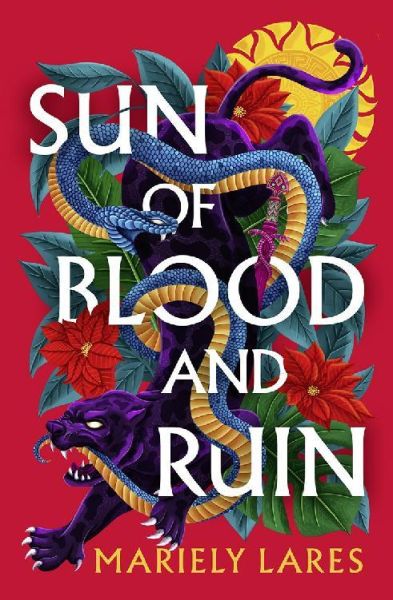Cunning and Free
Sun of Blood and Ruin
By Mariely Lares

23 Feb, 2024
Mariely Lares’ 2023 Sun of Blood and Ruin is an alternate historical fantasy.
Decades after Hernán Cortés invaded, Mexico is still divided. In the regions under Spanish rule, the largely indigenous population is subject to inflexible Spanish law and custom. Outside those regions, rebellion is rife.
Lady Leonora de las Casas Tlazohtzin’s position is an uncomfortable one. Her late father was Viceroy of New Spain. Her late mother, to whom the Viceroy was not wed, was indigenous. How to reconcile her two lineages?
By becoming the closest thing to a superhero New Spain has.
Leonora leads a double life. Publicly she is the bastard daughter of a Spanish aristocrat, promised to Prince Felipe of Spain. Privately, she is La Pantera, a shapeshifting freedom fighter who wields magic and steel to protect the people from the worst of Spanish oppression.
Whether La Pantera has made any significant difference is an open question. Nevertheless she is a thorn in the side of the colonizers, someone the Spanish authorities would like to see arrested and executed. La Pantera is adept at confronting, then eluding the men pursuing her. Cue angry fist-waving and vows to catch the fugitive on the part of Captain Nabarres.
Leonora is painfully aware that her birth was ill-omened. No doubt she is fated to die young. Given her frequent narrow escapes, and the unfortunate fact that her impressive abilities do not include invulnerability, if her death does not come on the point of Nabarres’ sword, it will come from a Spanish bullet.
Leonora’s precarious double life begins to fall apart. Her magic mirror is stolen from her by a dashing stranger. Soon after, her Sword of Integrity is likewise (temporarily) lost. Perhaps worse of all, Prince Felipe, who should be conveniently far away in Spain, appears, having been shipwrecked in the New World. Dodging unwanted marriage will be very hard when the groom is at hand.
Leonora needs a distraction. She gets it in the form of doomsday. Among the religious rituals banned by the Spanish, those needed to prevent the end of the current age. This presents an opportunity for Itzpapalotl, the Obsidian Butterfly, and her legions of star demons. Humanity is doomed, unless La Pantera and her allies can somehow defeat gods.
~oOo~
Obligatory “pre-and-post conquest Mexican history is not my field” disclaimer. Also, even ignoring the whole magic and gods are real elements, this appears to be an alternate history, so judging it by actual New Spain history could be a mistake. Nevertheless, I kept getting kicked out of the narrative by details that made me wonder if things work the way the author has them working. For example, Leonora’s brother:
Viceroy Jerónimo is the sovereign leader in New Spain, ruling in the name of King Carlos1, and wields absolute power, my half-brother is only fourteen.
Either the King of Spain appointed Jerónimo when the Viceroy was too young to wield power of his office or Jerónimo inherited the position. That does not seem to be how Viceroys of New Spain were selected.
As well, given Leonora’s barely tolerated position in New Spain society, her betrothal to Prince Felipe seems unlikely. Granted, Leonora is extremely beautiful — but would the future King of Spain, especially this future King of Spain, promise to marry a half-Spanish, half-indigenous Mexican woman, even given that woman’s father’s legal wife’s talent at conniving?
I will grant that there is a perfectly reasonable explanation as to how Felipe appeared when and where he did, one I will not spoil.
Leonora spends much of the book as a curious combination of adept and powerful, but also inept and powerless. She commands impressive martial and magical skills, both of which she deploys ineffectively. Thus the frequency with which she is forced to retreat and the difficulty she has holding onto her magic items. Though this may be an authorial choice to make her struggle against an actual god and an army of demons more suspenseful.
It is also possible the novel can be read as a critique of costumed adventurers like Zorro (to whom La Pantera bears close resemblance) and Batman. Pantera’s flamboyant dashing around and the humiliating defeats she visits on the Spanish don’t do much to improve her own lot or that of the people she wants to defend. If anything, she makes things worse. Perhaps confronting isolated social ills is an ineffective method of addressing systemic problems?
The plot itself is rather episodic, which in combination with the similarities to Johnston McCulley’s Zorro made me wonder how this would survive adaptation to television. Perhaps I will find out.
Readers more invested in high-stakes adventure and troubled romances, and less invested in quite possibly irrelevant background details may enjoy this novel more than I did.
Sun of Blood and Ruin is available here (Amazon US), here (Amazon Canada), here (Amazon UK), here (Apple Books), here (Barnes & Noble), here (Chapters-Indigo), and here (Words Worth Books).
1: It’s seems likely that King Carlos is Charles V, which would make Felipe Philip II. Carlos’ wife is named as Isabella, which lines up. Except the final Fire Ceremony seems to have happened in 1507, which would make the year 1559, by which point Philip II had had two wives die: Maria Manuela of Portugal (m. 1543; died 1545)), Mary I of England (m. 1554; died 1558)and was married to Elisabeth of Valois (m. 1559; died 1568). Either I am overthinking this or I am missing something very obvious.
